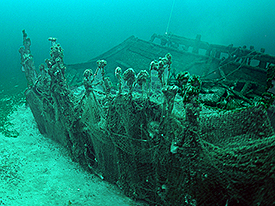
The Island City Wreck
21 September 2010
By Matt Carter

View showing the tangled nets encasing Island City. Large View (photograph courtesy of Tamara Thomsen).
The second project of my internship with the Wisconsin Historical Society is on the small lakeshoring schooner Island City. Early shipbuilding tradition on the Great Lakes saw the development of small purposefully built vessels in remote shipyards of the western frontier. These small vessels built for intra-lake trading were typically referred to as lakeshorers, trading or coasting schooners. Their diminutive size and shallow draft allowed the vessels to access the unimproved ports of the developing cites of the western Lakes. Compared to the canallers or grain traders who travelled great distances and traversed many of the Lakes, these small boats typically remained within the lake where they were constructed and preformed specific tasks for their owners.
The schooner Island City's build, career, and lifespan is typical of the lakeshoring schooner. Built in 1859 in the hinterland shipyard of Peter Perry on Harson's Island Michigan, the tiny 54-foot schooner kept to southern Lake Huron, Lake St. Clair, and western Lake Erie for the early years of her career. Used to transport general merchandise, produce and the occasional passenger, the Island City supported the needs of her owners (who switched several times) who were typically merchants and general store operators.
By 1865, the Island City was sold into the Lake Michigan lumber trade. Chicago and Milwaukee's voracious consumption of lumber created a great demand for ships of any size to meet the region's needs and thus saw a migration and conversion to the area of many small aging vessels. These vessels were inexpensive to purchase, and provided a gateway into the maritime trade for many immigrants arriving in the Midwest. Supported by the idea that since lumber floated it was not necessary to keep up with the ship's maintenance, it was expected that the lumber cargo would buoy the vessel, and many of these ships were sailed well beyond their life expectancy. Following several minor accidents and adding pressure to transport greater volumes of lumber, the Island City was rebuilt in 1877 and lengthened to 81 feet. She remained in the Lake Michigan lumber trade and passed from owner to owner every few years until her loss in 1894 in total 35 years of hard use.
The Island City survey will document the construction details of this small lakeshoring schooner. We are hoping to detail any evidence of repairs, the lengthening of the vessel, any changes to the vessel made to facilitate her use in the lumber trade, and to document any remaining cultural items on the wreck site. The Island City lies upright and slightly broken in 135 feet of water in a remote area on Lake Michigan. The site is only occasionally visited by divers because of the remote location with the additional determent that she remains heavily encased in fishing nets. Our first course of action is to remove a good quantity of the nets.
Overhead view of Island City in 135 feet of water. (Image courtesy of Wisconsin Historical Society. ). Click on map to zoom in for a closer look.
Return to MUA Project Journals home page.

